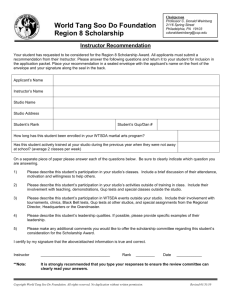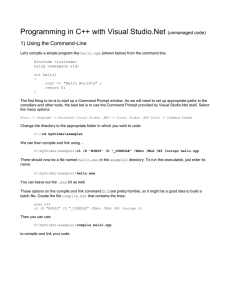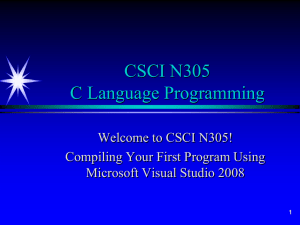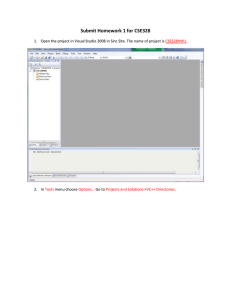Lab 1 - CMPS 1043, Computer Science I
advertisement
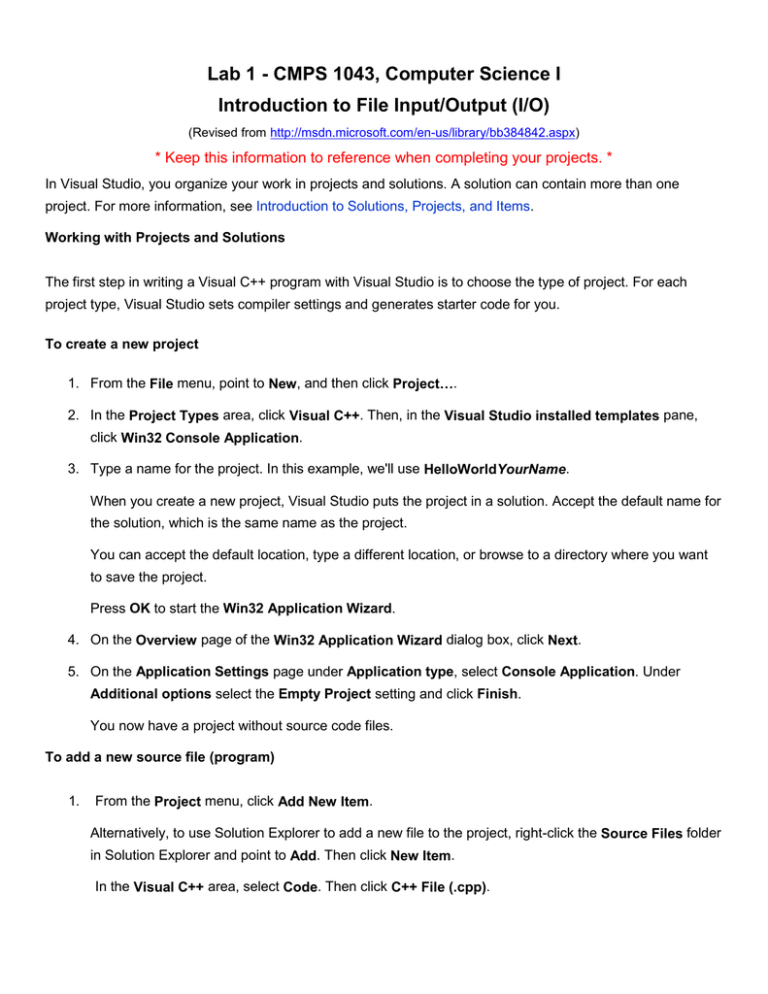
Lab 1 - CMPS 1043, Computer Science I
Introduction to File Input/Output (I/O)
(Revised from http://msdn.microsoft.com/en-us/library/bb384842.aspx)
* Keep this information to reference when completing your projects. *
In Visual Studio, you organize your work in projects and solutions. A solution can contain more than one
project. For more information, see Introduction to Solutions, Projects, and Items.
Working with Projects and Solutions
The first step in writing a Visual C++ program with Visual Studio is to choose the type of project. For each
project type, Visual Studio sets compiler settings and generates starter code for you.
To create a new project
1. From the File menu, point to New, and then click Project….
2. In the Project Types area, click Visual C++. Then, in the Visual Studio installed templates pane,
click Win32 Console Application.
3. Type a name for the project. In this example, we'll use HelloWorldYourName.
When you create a new project, Visual Studio puts the project in a solution. Accept the default name for
the solution, which is the same name as the project.
You can accept the default location, type a different location, or browse to a directory where you want
to save the project.
Press OK to start the Win32 Application Wizard.
4. On the Overview page of the Win32 Application Wizard dialog box, click Next.
5. On the Application Settings page under Application type, select Console Application. Under
Additional options select the Empty Project setting and click Finish.
You now have a project without source code files.
To add a new source file (program)
1.
From the Project menu, click Add New Item.
Alternatively, to use Solution Explorer to add a new file to the project, right-click the Source Files folder
in Solution Explorer and point to Add. Then click New Item.
In the Visual C++ area, select Code. Then click C++ File (.cpp).
2. Type the Name of the file to be added (for example, type HelloWorldYourName) and click Add.
The source file HelloWorldYourName.cpp will be added to the project.
3. In the HelloWorld.cpp editing window, type the code below for the HelloWorldYourName program. In
this example, HelloWorldYourName.cpp will be the main function. Note: Spacing and Indention are
important!!
#include <iostream>
using namespace std;
int main( )
{
cout << "Hello YourName!!!" << endl;
system (“pause”);
return 0;
}
4. To compile the program, on the Build menu, click Build Solution.
You should see output from the build in the Output window indicating that the project compiled without
errors. If not, correct the errors indicated in the Output window.
To execute the program
CTRL + F5 will compile and execute your program and will display your results in the display window. The
window remains open until you close it.
Alternatively - On the Debug menu, select Start Without Debugging.
To print the Output Window
In general, one does not print the contents of the Output Window. You will soon learn a better way to
produce output for printing using an output file. However, sometimes you will need to print this window.
1. CTRL + PrtScn will capture an image of the entire screen.
2. Do a PASTE operation into a blank document in some editor (Word, Notepad, etc.)
3. So that the output will be large enough to read, set the page to landscape and stretch the image to fill
the page. Print your document.
Printing your Program Code
With your program code displayed on the screen, click the Windows icon in the upper left corner of the
screen, select Print. If you are using a color printer, your printout will be in color as on the screen. If not, it will
be B/W. Color is NOT necessary for work turned in to your instructors. Lab printers are not color.
To add a text file
1.
From the Project menu, click Add New Item.
Alternatively, to use Solution Explorer to add a new file to the project, right-click the Source Files folder
in Solution Explorer and point to Add. Then click New Item.
In the Visual C++ area, select Utility. Then click Text File (.txt).
2. Type the Name of the file to be added (for example, type input if the file is to contain data to be read
by the program or type output if the file will have execution results written to it) and click Add. The
empty text file (input.txt or output.txt) will be added to the project.
Documentation
Good programming practice insists that all program files must contain documentation. That is, comments from
the programmer providing basic information about the program. Documentation lines begin with the //
symbols. All programs should have at least the following documentation at the beginning of EVERY program.
Your instructor may require additional documentation be included.
// Your Last Name, Your First Name
// Computer Science 1 - Instructor name
// Project # - Project Name
// Date
// Additional information as required by your instructor
This is the documented sample program from above.
// Your Last Name, Your First Name
// Computer Science 1 – Instructor name (Halverson or Donovan)
// Project 1 - Lab 1
// DATE
#include <iostream>
using namespace std;
int main( )
{
cout << "Hello Your Name!!!" << endl;
system (“pause”);
return 0;
}
LAB 1 – Assignment
After the lab instructor has walked you through the above material, close Visual Studio and start over.
Open Visual Studio and redo the program above ON YOUR OWN, but ask questions of the lab
assistants as necessary.
Complete the documented program above (with your name & current date).
Compile and execute, correcting any errors.
Save on your flash drive OFTEN!
Print a copy of (1) the program code and (2) the output window to turn in to your course instructor by
the first class meeting next week.
It is recommended that you try this exercise on your computer at home.

